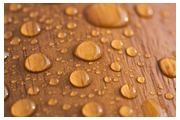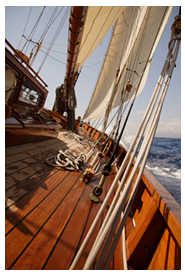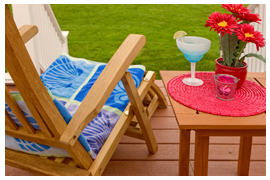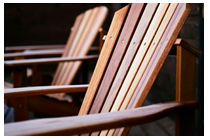 What wood should you use for your outdoor projects?
What wood should you use for your outdoor projects?
Good question. And the answer to this question begins with other questions: what would you like the wood to do? Keep its color and appearance? Remain flat and straight? Maintain structural integrity for years and years?
Believe it or not, how you choose to finish the wood and how diligent you are with caring for the finish has more to do with the endurance of your project than the hardwood you choose.
When using hardwoods for exterior projects you have four characteristics to consider:
- The final project’s exposure to weather and sunlight
- The wood’s resistance to decay
- The method of finishing, treating, or top coating the finished product
- Routine maintenance
 These are the things that determine the longevity of your projects that reside outside. In general, any wood will work for an outdoor project if it’s kept dry and regularly maintained. However, some woods do have a higher resistance to decay than others, and a list of such woods is below. Regardless, using hardwoods outside comes with trade offs: the wood will change in color and the end product must undergo regular maintenance.
These are the things that determine the longevity of your projects that reside outside. In general, any wood will work for an outdoor project if it’s kept dry and regularly maintained. However, some woods do have a higher resistance to decay than others, and a list of such woods is below. Regardless, using hardwoods outside comes with trade offs: the wood will change in color and the end product must undergo regular maintenance.
Weathering, Moisture, and Exposure to Sunlight
No wood will withstand weathering without chemical protection – left bare, hardwoods will turn gray in color, take on surface and end checking (cracking), and/or distort in shape (such as warping, twisting and crooking) as they absorb moisture and dry out. Different woods will react sooner than others in this department.
Sunlight is the demise of color and grain features in hardwoods that are left bare or not maintained regularly. To keep a wood looking like it did when you first finished the project, it’s imperative to use a UV blocking finish or top coat and keep it out of direct sunlight as much as possible. The general rule of thumb still remains: dark woods tend to get lighter with age, and light woods tend to get darker with age – regardless of the project being an interior or exterior one.
Increases in humidity cause the wood fibers to absorb the moisture in the air in an attempt to equalize with its environment. Wood is stable when it reaches the Equilibrium Moisture Content (EMC), but it takes time for wood to equalize. During this time, wood moves. It will swell (expand) along the rings of annual growth.
 Worse, when the air dries out (or the local humidity decreases), the wood will again attempt to equalize. As water escapes from the wood fibers, the wood will shrink – this is what causes end- and surface-checking, twisting, cupping, and crooking. Of course, these defects are augmented with rapid moisture changes. But woodworkers should know how to plan their joinery, panels, and components to allow for fluctuations with climate changes so as to minimize problems with their projects.
Worse, when the air dries out (or the local humidity decreases), the wood will again attempt to equalize. As water escapes from the wood fibers, the wood will shrink – this is what causes end- and surface-checking, twisting, cupping, and crooking. Of course, these defects are augmented with rapid moisture changes. But woodworkers should know how to plan their joinery, panels, and components to allow for fluctuations with climate changes so as to minimize problems with their projects.
Resistance to decay
Rule one: Keep your wood project dry, and it won’t decay.
Decay comes from fungus, and fungus needs certain conditions in order to live and cause damage. According to the Forest Products Society:
Eliminate any one of these and decay fungi cannot survive.
- An adequate supply of oxygen
- A favorable temperature (32° - 90°F)
- Moisture in excess of the fiber saturation point (> 25-30%)
- A suitable source of energy and nutrients (i.e. the wood)
For woodworkers making outdoor furniture (or homeowners using said furniture), the easiest condition to control is keeping the wood away from saturating moisture. An Adirondack chair, for instance, that’s left in the grass throughout Spring and Summer will probably soak in too much water at the legs, allowing fungus to grow and attack.
An afternoon rain storm isn’t going to pose a problem in respect to decay – after the rain has passed, the furniture will dry out. But remember the other problems, above, with wood as it dries.
You can improve your odds against fungus by using a hardwood that has a high resistance to decay; such as a dense or oily wood that soaks in water much slower than other woods.
Our List of Outdoor Woods:
Cypress
Guajayvi
Iroko
Merbau
Purple Heart
Sirari
White Oak
Cumaru
Genuine Mahogany
Ipe
Jarrah
Monkey Pod
Purple Heart
Teak
Curupay
Goncalo Alves
Iroko
Jatoba
Palo Maria
Purple Heart
Volador
Exterior Finishes for Hardwoods and Maintenance
Direct sun and exposure to water is hard on wood. A good finish for an exterior project will have UV protection and water repellants.
For projects like decks, we see many South American species like Ipe, Cumaru, and Massaranduba used bare. This is simply a choice made by the end user who either prefers the gray weathered look (or doesn’t mind it), and accepts this as the most maintenance-free method of a wood with high resistance to decay. These woods will do well outside without chemical protection for years to come, assuming that they don’t get saturated with water and are not in direct contact with the ground.
 Otherwise, to have a hardwood keep (as close as possible) its color and grain characteristics, you’ll need to apply an exterior grade finish and then maintain that finish. Maintenance can be as frequent as three months depending on the severity of the project’s exposure to the elements, the quality of the finish, and the quality of labor that went into applying the first coats of finish. A good finish that’s applied correctly on an exterior project may not need any additional care for two years.
Otherwise, to have a hardwood keep (as close as possible) its color and grain characteristics, you’ll need to apply an exterior grade finish and then maintain that finish. Maintenance can be as frequent as three months depending on the severity of the project’s exposure to the elements, the quality of the finish, and the quality of labor that went into applying the first coats of finish. A good finish that’s applied correctly on an exterior project may not need any additional care for two years.
Good Outdoor/Exterior Wood Finishes:
Penetrating exterior oil: The easiest exterior finish to apply and maintain, and several brands are available with UV protection through your local woodworking supply or hardware store. Depending on the level of exposure, this type of finish needs to be re-applied as often as 6 months. But it does not require stripping, simply clean, dry, and re-coat your project.
Varnish: This type makes a hard shell coating on the wood surface, and many people prefer the gloss or satin look of a clear coat shell on exterior doors. A marine spar varnish is the most appropriate to use outdoors, and many brands are readily available also with UV protection. The varnish shell can be compromised (by cracking or peeling) as the wood expands and contracts with climate changes, or if the UV protection is of low quality or is old. The initial finish should have 8-10 thin coats; for maintenance, it needs to be sanded (or in some cases stripped), then re-coated with at least 3 coats . It’s more intensive to maintain than oil, but it also provides a different look. Varnish also turns yellow with age.
Epoxy resin: The boat maker’s choice, which is used for fiberglass. Most likely very overkill for your backyard patio furniture project or exterior door, but it’s another option that’s very durable.
Paint: The most weather resistant wood finish is paint, either latex or enamel depending on the project. Hardwoods with high density should be primed in order for the paint to last, but the final product should be able to go for many years without additional care. Of course, if you’re using a hardwood for an outdoor project you probably want to be using a finish that is clear to exhibit the grain and color – paint is not the choice. But it is worth noting that this is the most weather resistant way to coat wood that’s also easy to apply and maintain.
Sources:
Forest Products Society: www.forestprod.org
Forest and Shade Tree Pathology: www.forestpathology.org
Iowa State University Forestry Extension: Finishing Exterior Wood Surfaces, by Dean R. Prestemon

